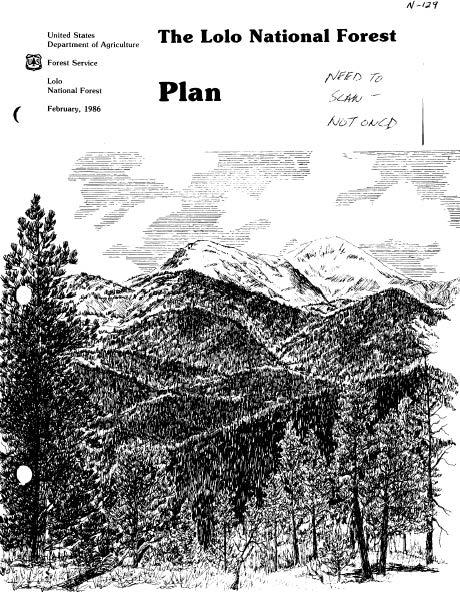
Most people view the problems of forest management from the narrow perspective of their own interests. They understand that there are “many great interests on the National Forests which sometimes conflict a little,” as Gifford Pinchot described the situation a century ago. While we must honor specific interests, the Forest Service’s charge under Organic Act of 1897 stewardship framing, then broadened and altered by subsequent law is more complex. It is never as easy as getting folks together to sit across a table and working out a “forest plan.”
The Forest Service came into being at the end of a very rapacious period in American history. Hence the emphasis on “reserves” in the Organic Act , and later in the Weeks Act of 1911. The public lands had been attacked by many as the so-called settlement of the American West proceeded after the Civil War. It was perceived and used as a “commons” and plundered and burned in too many places. That caused the public outrage that led to the forest reserves.
After successfully bringing the reserves into the national forest system, Gifford Pinchot wanted to regulate all forest practices in the US. Pinchot could not achieve his dream, and the private lands were over-cut for a long time. Even Weyerhauser, where I worked for a summer in the late 1970s—and deemed the “Best of the SOBs” by Forbes magazine, knew but were reluctant to admit in public that their “fee lands” were being cut faster than their “High Yield Forestry” tree farms could replace the volume being cut and milled during that late period of the US housing boom. There would be a “gap.” And sure enough, just as soon as their and other private land owners “gaps” appeared the pressure mounted to cut the national forests. And cut they did, until the environmentalists, working public attitudes/pressures/law shut it down, amid great angst for locals particularly in the Northwest.
As the timber wars raged, more people with new-found affluence were using the national forests and more conflicts emerged between recreationists and cattle and sheep grazers on the national forests. And there were two emergent back-country recreationist movements that were destined to clash one with another: the “primitive back-packers” and the “ATV/OHV users”. In addition, primitive canoe, kayak, float boat enthusiasts were clashing ever-more with commercial outfitters and motorboat enthusiasts, not to mention personal watercraft. And then there were Wilderness advocates clashing against motorheads of all ilks. The wars were on.
Amid this upwelling of controversy, the US Congress penned the Renewable Resources Planning Act of 1974. But before the ink dried on that law, timber cutting on the national forests, clearcutting to be precise slammed to an immediate legal halt via a lawsuit on the Izaak Walton League. Then under a panic to reopen clearcutting on the national forests, the National Forest Management Act of 1976 was born, and so was forest-level planning. But there was little in either the RPA nor its amendment the NFMA that was destined to settle the controversies. The controversies were the stuff of wicked problems in public forests as noted first by Allen and Gould in 1986.
So here we are more than 30 years after NFMA, with the same controversies raging, overlaid by more people wanting more (and different) things from the national forests, more people living much closer to the national forests, global climate change controversy, species loss controversies that stem from more people (and roads/dams/power lines/energy corridors/etc.) across the landscape and from more stress on both “sources” (resources) and “sinks” (particularly air and water sheds where pollution is dumped)added in, etc..
And all the while the Forest Service continues to pretend that forest planning, pretty much as designed in the late 1970s, but having dropped economic rationality in favor of ecological rationality, will somehow save the day. Or at least that’s how I read the Draft Planning Rule (pdf)
It is my feeling that the only path forward that will afford any chance to allow forest users to sit across tables and talk seriously about prudent use of individual forests, watersheds, or mountain ranges, is for their to be some means to continue to discuss, debate, and develop policy for “broader scale” issues that will set boundaries on discussions of use and conservation at “local scales,” including but not limited to the national forest-scale.
That is why I continually suggest that an Adaptive Governance approach be developed in the NFMA rule. It could as well be developed apart from the NFMA rulemaking process. But until and unless it is developed, there is little or no chance that national interest groups will allow for the type across-the-table “use discussions” that more local interest groups advocate. This conclusion is not mine alone. Consider this from 1999, subtitled Making Sense of Wicked Problems:
What is the answer then, to these complex (wicked) problems? How do we organize ourselves to deal with diverse values and expectations about sustainable forest management? Shannon (1992) asserted that the answer lies in the notion of informed governance. That is, we need places where people can learn, question, debate, and come to an informed judgment of what choices are best (FEMAT 1993). In Coming to Public Judgment , Yankelovich (1991) determined that the most critical barrier to making effective and informed choices in a complex world is the lack of forums in which the process of “working through” value differences and preferences can occur. There is growing support among natural resource professionals that a public dialogue must be an integral part of achieving social and political acceptance of forest practices (e.g., Bengston 1994, Clark and Stankey 1991, Shepard 1992). Regardless of value differences, if people are to come to an understanding of, if not agreement on, the problems and choices that confront public lands management, it is likely to be in public forums where open and honest discussion can occur. Unfortunately, from their research on adaptive approaches to forest management, Stankey and Shindler (1997) conclude that such forums are most notable by their scarcity. (emphasis added)
Anybody want to explain to me where I (we) have got it wrong?
[Note this post was precipitated by this comment. Thanks Brian]






